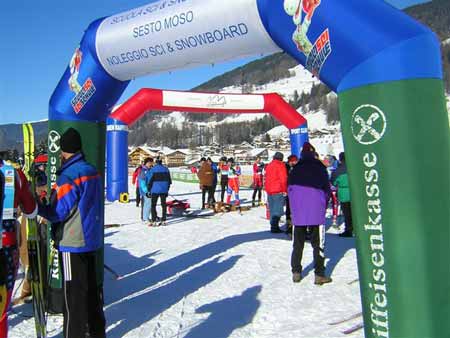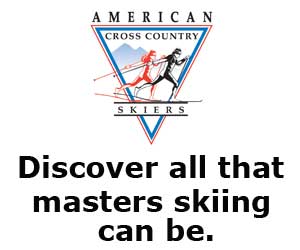
The Pustertaler Lauf
Race Story
Thu, Feb 16, 2006 - By Hugh Pritchard
It might seem strange, but if you find yourself in Britain, London is a great place to be based if you are a cross-country skier. The availability of budget flights to numerous airports throughout Europe makes weekend trips a very realistic possibility, and by making arrangements well in advance it is possible for ski racing to be a very affordable hobby for a Londoner.
The Pustertaler Lauf is typical of the races that go on all over western Europe every weekend through the winter: fields of a few hundred in each race; the winners at international standard; a well-established organisation; a beautiful setting. It is slightly unusual in having two races: a 28km classic on the Saturday, and a 42km skate on the Sunday.
I got up hideously early on the Friday morning to catch the flight from London to Venice, with my companion for the weekend: Peter Kuznetsov, a Russian living in London (who won the British roller-ski championships last summer – but that is another story). It seemed odd to be emerging from the airport to see palm trees, but the temperature was cool. We hired a car and headed north for the Dolomites.
Toblach is in the South Tirol, just north of Cortina, the 1956 winter Olympic venue. The South Tirol was part of Austria until the First World War, so the language is German and the architecture Tirolean. The food combines the best of Austrian and Italian, which is one of the great things about this area. Each town has two names: a German and an Italian.
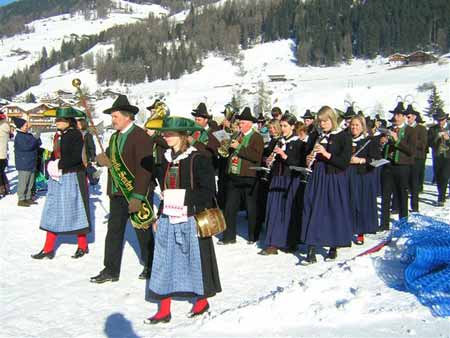
Toblach itself is picturesque, and is placed where the main road to Cortina meets the Pustertaler valley. The ski trails run along the valley in both directions, and towards Cortina; there are various side-trails up from the main valley – they claim 200km of trails, and it looks like you can ski on over the border into Austria as well. Trail fees? N the local authority maintains the trails in order to make the area attractive to tourists, for the benefit of local businesses, which therefore bear the cost. The trails run on private land, as everywhere in Europe, but the landowners presumably charge no significant rent.
Peter and I arrived at our hotel Friday lunch-time – Peter had had a last-minute panic when the Italian consulate said that he could only have a six-month visa if he could tell them where he was staying on his first night, so he had phoned and booked the first hotel that he could find. The Toblacher Hof turned out to be a very smart place – family-owned, as different as you can imagine from a bland chain hotel, and very reasonably priced. The wax-room was an unheated garage, which was not ideal with temperatures of -20C outside, but a word with Stefan got us into the heated garage; the owner did not seem keen, and grunted that we should be careful with his two very fast-looking sports cars.
We did an hour’s easy skating, checking out the early part of the course and a couple of the hillier parts of the trail system (the hills are not part of the marathon courses, but are used for FIS races), before fetching our race packs, getting the tips from the Swix service team and settling down to waxing and supper.
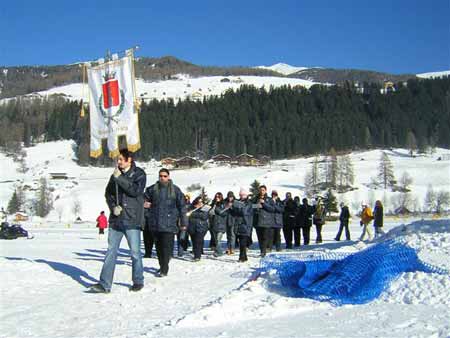
Although the snow conditions were good, we ironed in the thinnest possible layer of green klister as a base-binder to keep our stick-wax on against the cold, abrasive snow.
Race morning was, as forecast, cold. The start area was no more than 300 yards ski from our hotel, and we were able to walk just a few yards from the hotel before skiing to the start. We bundled our clothes into the sacks provided, slung them onto the lorry, and made our way into the first of the three start pens, to stand at the back of the first start group: we both believe in conservative starts.
The start area at Toblach is in the shade in the mornings, so it remains very cold, and it is necessary to do a lot of jumping around to keep warm.
The gun went, the row of firemen lifted the tape above their heads for us to ski under, and we were off: some 500 racers, nice wide tracks with plenty of classic spoor. Peter and I had a reasonably easy time of it, choosing not to duel with the excitable youngsters, and settled into a rhythm. By the time we got out of the start field my feet were going numb, so I was grateful to start kicking.
The track passed through the centre of the village before turning up towards Cortina for a few miles of very gentle climbing: kick-double-pole all the way. The track then returned down the same valley, and went over a couple of the hills of the FIS race track, along the main valley to the next village, and again up to the finish.
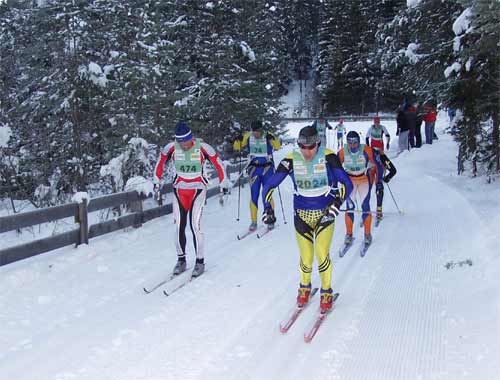
Hugh (right front, yellow suit & Team NordicSkiRacer hat) leading a small group.
I came in 37th: early enough to beat the scrum at the feed table, and not to feel guilty about keeping the blanket that was put over my shoulders when I arrived. Best of all was the announcement a few minutes later that the first woman was about to finish: being ‘gurled’ is too common an occurrence these days.
Peter arrived a few minutes later, having lost all his grip wax, and after changing we boarded the provided bus back to Toblach.
In the afternoon, after visiting the local hot-air balloon festival we drove to Sexten to ski the last few km of Sunday’s skate race, and were alarmed to find a horrifyingly steep and big hill some 3km before the finish. Forewarned is forearmed, we told ourselves, and visualised how we might have skied this hill in our youth, in a 5km race…
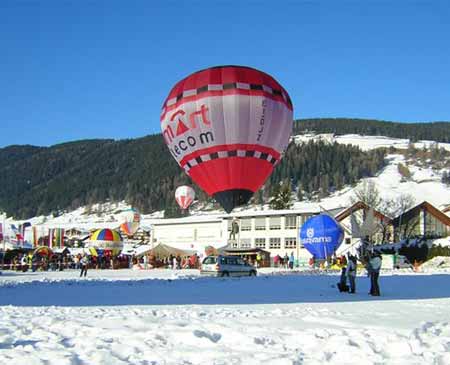
We stopped on our way back for the awards ceremony, held in the town square at Innichen, where the trail turns up from the main valley towards Sexten. Innichen is a very picturesque and typically Tirolean village, rather older and more authentic than Toblach (or, at least, New Toblach). The ceremony started with a very efficient MC rattling off his piece, first in German, then in Italian. Then the town bore took over, shuffling his great sheaf of notes… After 20’ of his drone, Peter and I went for a stroll down the high street; he was still at it when we returned, so we went and took a look round the old church. The old church date from the 11th to 14th centuries, and is lovely inside; unusually, there is a new church right next to it, of much the same size, in the usual Tirolean style, with its white exterior and onion dome, dating, I guess, from the late 18th century.
Well, after this diversion the bore was still at it – what is it that makes these people take a prize-giving as a chance to make people listen to them? We left to make ready for Sunday’s race.
The skate race is the more prestigious event: its field was a little larger at 650, and the top of the field was of somewhat higher quality, with several occasional members of the Italian team present. The start was much as the day before: same place, same format, same cold temperature, and the track followed the same route for the first few miles.
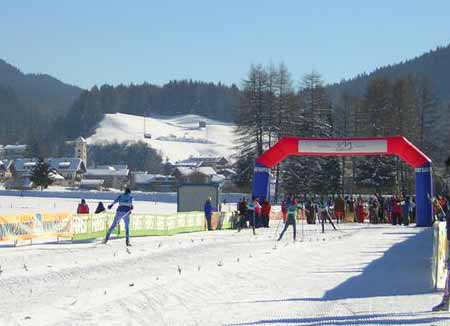
Returning to Toblach, the track turns right down the valley to Innichen, before climbing steadily to the finish at Sexten. Much of the track is not wide, and unfortunately, racers in Italy take to heart the fact that in marathons, unlike in time-trial racing, one is not obliged to give way to an overtaking racer; it is therefore very difficult to get past people where the track is not wide – and for some reason, there was a classic spoor along the entire length of the race track. This was not a problem in my part of the race, but I understood that it could be a little frustrating for some further back.
We finished the race, I again just ahead of the first woman and Peter just behind; the finish was in glorious sunshine, with not one but two of the local brass bands adding to the traditional Alpine feel of the event. This time, we found the post-race meal, and were astonished: a full three courses of good food, in a big, heated hall in the village… How careless not to have remembered it after the classic race.
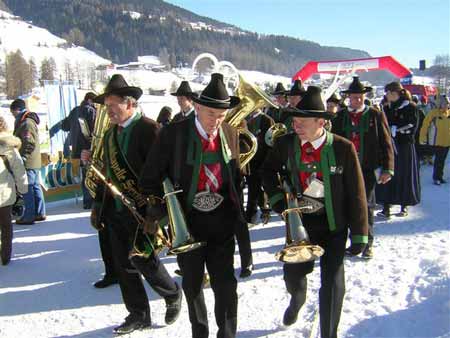
Then the bus back to Toblach, a quick errand to Obertilliach and the drive back to Venice. Any drive out of the Italian mountains is bad on a Sunday night, and this was no exception: after a good start, we took three hours to cover 20 miles, before reaching the autostrada, where we covered the last 60 miles in an exciting half-hour, barely making our flight back to London.
Information
The Pustertaler Lauf is at www.ski-marathon.com
The more famous Dobbiaco-Cortina race is at www.dobbiacocortina.org (Dobbiaco is the Italian name for Toblach)
The Toblacher Hof is at www.toblacherhof.com/
Free buses transport racers between the various villages and the start and finish points; I would suggest Innichen as the most picturesque place to stay, Toblach as the most practical.
We used Venice Marco Polo airport; it would be worth checking out Venice Tarvisio, Innsbruck and Klagenfurt for alternatives.
Costs (per person)
| Flight from London: | $203 |
| Car rental and fuel: | $119 |
| Hotel (2 nights half board): | $134 |
| Other meals and expenses | $39 |
| Entry fee: | $51 |
| Total cost for a 3-day ski trip with 2 great races: | $546 each |
[Want more? Read about Hugh's experiences at The Tannheimertal Ski-Trail race!]
